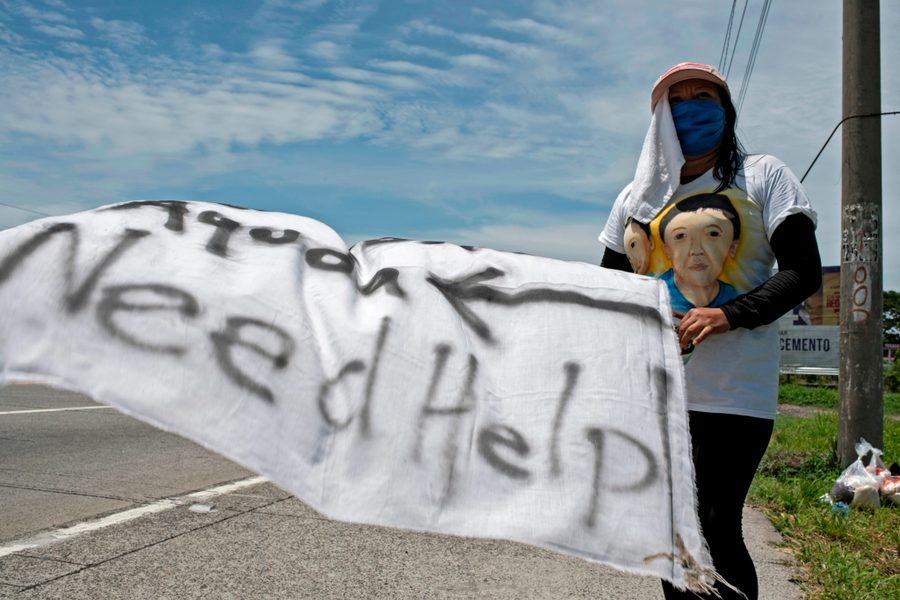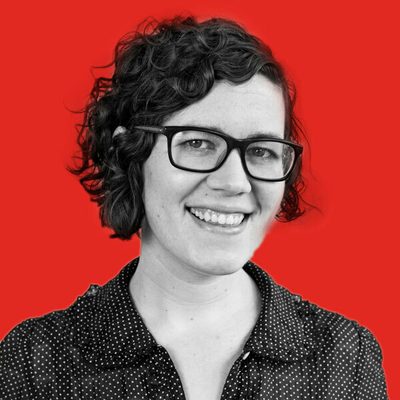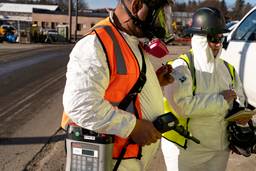This Obscure Financial Tool Could Help Global South Countries That Are Drowning in the Pandemic
Here’s why some of the IMF’s biggest critics are calling on it to issue “special drawing rights.”
Sarah Lazare

The International Monetary Fund (IMF) is widely reviled for its predatory lending practices in the Global South, where it has worked with the World Bank since the 1980s to impose disastrous “structural adjustment programs” that have unleashed austerity and drained public sectors. It’s an institution that maintains the neocolonial economic order to this day, but now, some of its biggest critics are calling on the IMF to provide immediate material relief to many of those same Global South countries, which are suffocating under a brutal pandemic.
Advocates are asking the IMF to issue Special Drawing Rights (SDRs), a complex mechanism that is the moral (if not literal) equivalent of giving money to struggling countries with no strings attached. To be clear, the IMF is doing active harm during the Covid-19 crisis — its current practices in Lebanon provide a harrowing example. So some critics may question any strategy that depends on the international body. But given that there are currently no alternative international financial institutions of the IMF’s magnitude, left economists say that SDRs are urgently needed to rescue public health systems and save lives, and without the damaging conditions of the IMF’s other forms of “aid.” The push for SDRs is somewhat similar to demands on the World Trade Organization to suspend patent rules to expand vaccine access — in both cases, activists are appealing to institutions they know are actively harmful.
There is some political momentum behind SDRs: Earlier this month, the IMF approved an allocation of SDRs worth $650 billion, and in late July, the House passed an amendment to the annual State Department appropriations bill calling for a dramatic increase to this amount.
Yet, while there are a number of grassroots organizations working on this issue, large swaths of the U.S. left seem unaware of the details of what SDRs are, and how they fit into an internationalist politics. This is understandable: The mechanism is complicated, and the IMF is not exactly known for its transparency. In These Times spoke with Mark Weisbrot, an economist and co-director of the Center for Economic and Policy Research, a left-leaning think tank, about what SDRs are and why the U.S. left should care about them. “SDRs can save many lives,” he says, “especially in a time of economic crisis and pandemic, by providing reserves that help stabilize economies in developing countries, and also directly by freeing up other resources for the import of essential medicines and health infrastructure, as well as food.”
I have felt for a while that most people don’t really understand the issue of Special Drawing Rights (SDRs). Can you explain to me what SDRs are, and why they matter?
Special Drawing Rights are an international reserve asset that is created by the IMF. An international reserve asset is something that is held mostly by central banks, because all central banks have to have some kind of international reserves in order to meet the needs of their economies — both the public and private sector — for international transactions, such as imports. Roughly 60 percent of the reserve assets held by central banks today are in U.S. dollars — this is one of the main things that gives the U.S. government a large degree of power and control over the international financial system.
Why do SDRs matter? Well, first, because countries need reserves, especially for essential imports like food and medicine. If they run low on reserves they can also have serious problems, including economic crises (e.g. balance of payments crises, debt crises, exchange rate-related crises).
The economic effects of the recent world recession have killed many more people than died from Covid-19 in low-and-middle-income countries. The World Food Program’s latest estimate from June 2021 is that the number of people facing food insecurity rose by up to 120 million since before the pandemic, an unprecedented 81 percent increase.
When the Covid pandemic hit, in March 2020, IMF managing director Kristalina Georgieva proposed that the IMF should do a special issuance of SDRs to help developing countries. She noted that the financing needs of developing countries — an IMF concept that basically describes what countries need in order to avoid balance of payments or fiscal crises — was on the order of $2.5 trillion, and that this estimate “is on the lower end.” The Trump administration immediately vetoed the idea.
But a number of organizations that cared (mine included) about the millions of people who were being thrown into poverty and extreme hunger, with many dying as a result of the pandemic and recession, went to Congress, which has the power to overrule the administration on this decision. As a result, the U.S. House of Representatives passed legislation requiring our government to support an issuance of 2 trillion SDRs at the IMF (equivalent to about $2.8 trillion). Republicans blocked it in the Senate.
But when Trump left, the Biden Treasury decided to support an issuance of about $650 billion of SDRs, about 23 percent of what the House wanted. The $650 billion is close to the maximum of what the Treasury can vote for at the IMF without getting approval from Congress.
So is it like printing money? Does it cost anything? The IMF can just give SDRs out whenever and however it wants?
Very good question. Here is where I think there is a lot of confusion about SDRs. The IMF is not a central bank with a world currency. So, creating SDRs is not the same as our central bank, the Federal Reserve, creating dollars. SDRs are not a currency.
However, under the rules of the IMF, if a country can show need, it can change its SDRs into what we could call a hard currency. There are five currencies that are used to determine the value of the SDR. The two main ones that countries choose are U.S. dollars and Euros, and it’s overwhelmingly dollars that are chosen, because that’s the main currency in the international financial system. So that’s what enables the SDR to function as a reserve asset: because it can be exchanged for hard currency.
It doesn’t cost anything for the IMF to create the SDRs, nor does it cost anything for the U.S. government or any other government. In a way, it is something like the quantitative easing that the U.S. Federal Reserve is doing right now for the U.S. economy — creating $120 billion a month. But, of course, it’s different because SDRs are not currency.
The IMF can do these special issuances whenever the IMF’s board of governors decides to do it, but it has been rare. The last one was during the 2009 world recession.
So, it’s the equivalent of giving money to countries that are really struggling right now?
Yes, although according to IMF rules, the SDRs go to all 190 member countries of the IMF in proportion to their quota at the IMF. This means that high-income countries like the United States and European countries get about 60 percent of the SDRs in the current issuance. However, the high-income countries won’t use them, so there is no cost or use of resources when these assets are created for the high-income countries.
Some of the opponents of SDR issuance, which included Mnuchin when he was Treasury Secretary, have made an issue out of the majority of SDRs going to high income countries. But this is just an argument for having a bigger issuance, and for changing the distribution of SDRs if that becomes possible. It’s not an argument that there is some downside impact of creating the SDRs right now, or that the high-income countries are getting any real resources from this issuance.
If someone were to ask you to describe what SDRs are and why they’re important in one sentence, what would that sentence be?
SDRs can save many lives, especially in a time of economic crisis and pandemic, by providing reserves that help stabilize economies in developing countries, and also directly by freeing up other resources for the import of essential medicines and health infrastructure, as well as food.
My understanding is that the IMF is a pretty harmful institution, and you just told me that rich countries get more SDRs. I’m very familiar with the history of IMF loans being tied to extremely damaging reforms like structural adjustment programs. Do these SDRs have the same conditions? Why work with an institution like the IMF?
I have written numerous papers and some book chapters over the last 20 years that criticized, in some detail, IMF macroeconomic policies and the conditions attached to their lending. And I have engaged in public discussions and debates with IMF economists. And you can see that something is very wrong, from the above story of how Mnuchin was able to instantly kill a vitally important policy that was wanted by at least 180 of 190 member countries — probably more — representing the vast majority of the world’s population.
But the SDRs are a different story — they are not loans, do not have to be paid back, and there are no conditions attached to them. So, even the $650 billion worth of SDRs approved last week — while not nearly enough — is a historic victory. It’s more than twice the last issuance of 2009, which was itself more than twice the cumulative number of all SDRs issued previously. So, there is no downside to this particular policy, and it could save many lives.
I want to speak to questions a left audience might have, which is, shouldn’t we just get rid of the IMF altogether? Or do you see the SDRs as an immediate-term issue but the long-term issue is changing or abolishing the global financial institutions that govern our international economy?
There are similar problems with the biggest “institutions of global governance”: the IMF, the World Bank and the WTO. They are controlled by an alliance of the most powerful people in the richest countries. Europe almost always votes with the United States, and together the high-income countries have more than 60 percent of the vote. The United States has its own, single-country veto over the IMF’s most important decisions. The WTO operates according to rules that were written by the rich countries — many of their most important rules were written by U.S. and European corporations; hence the terrible, deadly vaccine apartheid that most of the world is facing right now, which could itself cost millions of lives.
So, the control of these institutions by an alliance of rich-country governments is a serious problem. The IMF is the most powerful of them, but it lost a good deal of its power in the first decade of the 21st century. This was partly due to its involvement in a series of policy choices that were, correctly, seen by a number of prominent economists as serious failures, near the turn of the century: the Asian financial crisis of 1997 to 1999, and the Argentine depression of 1998 to 2002. Subsequently, many countries took more measures to avoid having to borrow from the IMF. The unprecedented independence of many Latin American governments, achieved in the first decade of the century, also pulled a lot of the IMF’s middle-income clients out of its orbit, although some of this has been reversed in recent years.
In any case, it is not clear to what degree these institutions will be reformed, democratized, change their policies, or be superseded. A lot will depend on what the member governments do in the future.
I have not seen a lot of discussion on the Left at all about SDRs. It seems that many people don’t deeply know about the issue. What is your case, say if someone reading this interview identifies as being a part of the Left in the United States, for why they should care about SDRs?
Well, more than 100 organizations, representing millions of people in the United States, participated in the congressional effort that resulted in the House passing legislation for at least 2 trillion SDRs. And the Left was certainly represented there.
I would add first and foremost that it’s not over: There is currently legislation in Congress for the U.S. government to support an IMF issuance of the majority of the SDRs that were approved by the House last year, but did not make it into the issuance of $650 billion earlier this month. The effort for the additional 1.54 trillion SDRs is being led in the House by Reps. Chuy Garcia and Jan Schakowsky (both from Chicago) and Mark Takano (California), and the Congressional Progressive Caucus, and by Senator Dick Durbin of Illinois.
The other main arguments are the ones that I have mentioned: This is a progressive structural reform that can save many lives, not only at present but in the future, even more if it becomes a regular policy option. (A similar statement could be made for our present unprecedented fiscal and monetary policy in the United States). The use of SDRs to stabilize the world economy would, over the intermediate and long-term, allow low-and-middle income countries to avoid some of the worst political and economic consequences of global downturns, which can push them further into debt, prolonged recessions or depressions, and rob them of the independence to pursue the development of policies that they need to improve peoples’ lives.
Sarah Lazare is the editor of Workday Magazine and a contributing editor for In These Times. She tweets at @sarahlazare.








